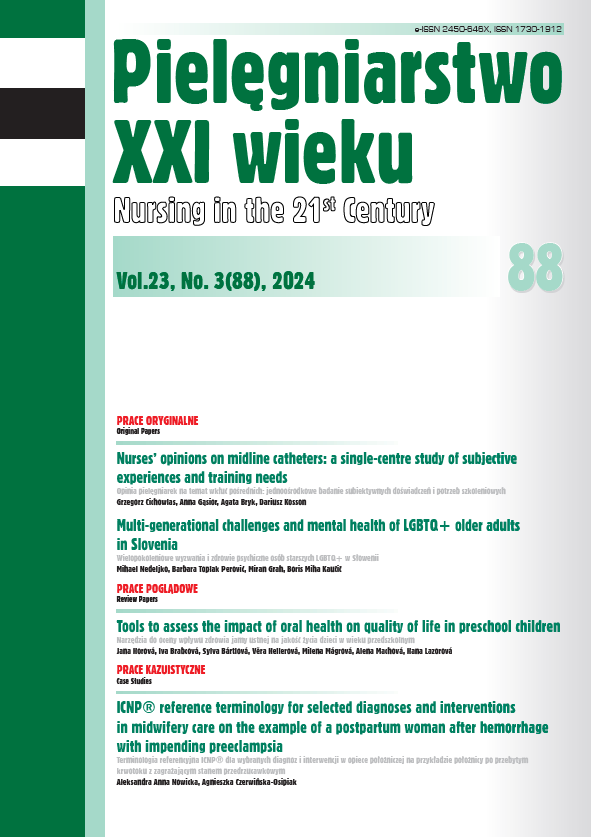ICNP® reference terminology for selected diagnoses and interventions in midwifery care on the example of a postpartum woman after hemorrhage with impending preeclampsia
DOI:
https://doi.org/10.2478/pielxxiw-2024-0040Keywords:
midwife, case study, postpartum hemorrhage, preeclampsia, patient care planningAbstract
ICNP® REFERENCE TERMINOLOGY FOR SELECTED DIAGNOSES AND INTERVENTIONS IN MIDWIFERY CARE ON THE EXAMPLE OF A POSTPARTUM WOMAN AFTER HEMORRHAGE WITH IMPENDING PREECLAMPSIA
Aim. The aim is to indicate the validity of implementing the ICNP® terminology in obstetric care on the example of a patient after postpartum hemorrhage with suspected preeclampsia. Based on the catalog of concepts, the entity’s problems and the midwife’s interventions were identifi ed in the proposed individualized care plan.
Material and methods. The research method in this work is an individual case study. The basis for the presented care plan was the use of techniques: interview, observation, analysis of medical documentation and measurements relevant for therapeutic purposes. This manuscript was developed based on the CARE protocol for case reports.
Results. The presented care model allowed for the implementation of individualized interventions, resulting in the improved quality of life and a better prognosis in the subject’s recovery process. The role of a midwife in the care of a patient with the previously mentioned diseases indicates the indispensable affi liation to an interdisciplinary team, at the same time establishing an independent and autonomous profession.
Conclusions. The use of the ICNP® classifi cation promotes the development of nursing as a fi eld of science. The indicated method allows for accurate interpretation of problems in the obstetric care, thus unifying the communication system based on databases and currently functioning catalogs of concepts.
References
1. Watkins EJ, Stem K. Postpartum hemorrhage. JAAPA. 2020;33(4):29-33.
2. WHO recommendation on routes of oxytocin administration for the prevention of postpartum haemorrhage after vaginal birth. Geneva, Switzerland: World Health Organization; 2020, p. 8-9.
3. Kwiatkowski S, Huras H, Fuchs T, et al. Rekomendacje Polskiego Towarzystwa Ginekologów i Położników. Postępowania w przypadku wystąpienia krwotoków okołoporodowych. Ginekol. Perinatol. Prakt. 2022;7(1):34-45.
4. Nowacka E, Andres J, Basta A, et al. Postępowanie interdyscyplinarne w krwotoku położniczym – konsensus lekarza anestezjologa i lekarza położnika a.d. 2016. In Warszawa: Medical Art Group Sp. z o.o.; 2016. Available from: https://meringer.pl/wp-content/uploads/2018/02/Postepowanie-interdyscyplinarne-w-krwotoku-polo%C5%BCniczym.pdf
5. Bręborowicz G, Czajkowski K, ed. Położnictwo. Wydanie III. Warszawa: PZWL; 2020, s. 239-255.
6. Filipek A, Jurewicz E. Preeclampsia - a disease of pregnant women. Postepy Biochem. 2018;64(4):232-229.
7. Iwanowicz-Palus G, Bień A, ed. Techniki położnicze i prowadzenie porodu. Wydanie I. Warszawa: PZWL; 2023, s. 523-535.
8. Ma’ayeh M, Costantine MM. Prevention of preeclampsia. Semin. Fetal. Neonatal. Med. 2020;25(5):101123.
9. Kilańska D. International Classification for Nursing Practice (ICNP®) - current state in the world and the stage of preparations for implementation in Poland. Nursing Problems. 2009;17(3):235-245.
10. Kilańska D. Raport z implementacji Klasyfikacji ICNP (Międzynarodowej Klasyfikacji Praktyki Pielęgniarskiej) do nauczania pielęgniarek i położnych w Polsce. Informacja z badania. In Łódź; 2014 [cited 2024 Jul 5]. Available from: https://pielegniarstwo.umed.lodz.pl/wp-content/uploads/2017/12/22_MZ-raport-dydaktyka-ICNP-2014.pdf
11. Kilańska D, Staszewska M, Urbanek N, et al. Care planning according to the international standard ICNP® in Primary Health Care — a case study of individual. Nursing Problems. 2015;22(4):539-545.
12. Kisilowska M. Międzynarodowa Klasyfikacja Praktyki Pielęgniarskiej - narzędzie zarządzania wiedzą w opiece zdrowotnej. Biuletyn EBIB. 2005;69(8).
13. Strategia na rzecz rozwoju pielęgniarstwa i położnictwa w Polsce. DZ. URZ. Min. Zdr. 2017.50 2017.
14. Zawidzka M, Haor B. Mapowanie pojęć ICNP® na przykładzie procesu pielęgnowania pacjenta z reumatoidalnym zapaleniem stawów. Innowacje w Pielęgniarstwie i Naukach o Zdrowiu. 2019;4(1):107-119.
15. Lesińska-Sawicka M, Kapała W. Metoda case study w pielęgniarstwie: wybrane zagadnienia. Wydanie I. Lesińska-Sawicka M, editor. Warszawa: Borgis Wydawnictwo Medyczne; 2009, p. 16-35.
16. Kilańska D. Wskaźniki jakości opieki i ich wykorzystanie w praktyce. Zasady korzystania z narzędzi, ewaluacja i walidacja skal oceny statusu zdrowotnego. [Internet]. Akredytowane Centrum Badania i Rozwoju ICNP ® przy Uniwersytecie Medycznym w Łodzi; 2015. Available from: http://a.umed.pl/pl/_akt/inf_tmp/2015/wskazniki%20jakosci%20HOBIC%20-%20skale%20ICNP.pdf
Downloads
Published
Issue
Section
License
Copyright (c) 2024 Authors

This work is licensed under a Creative Commons Attribution 4.0 International License.




